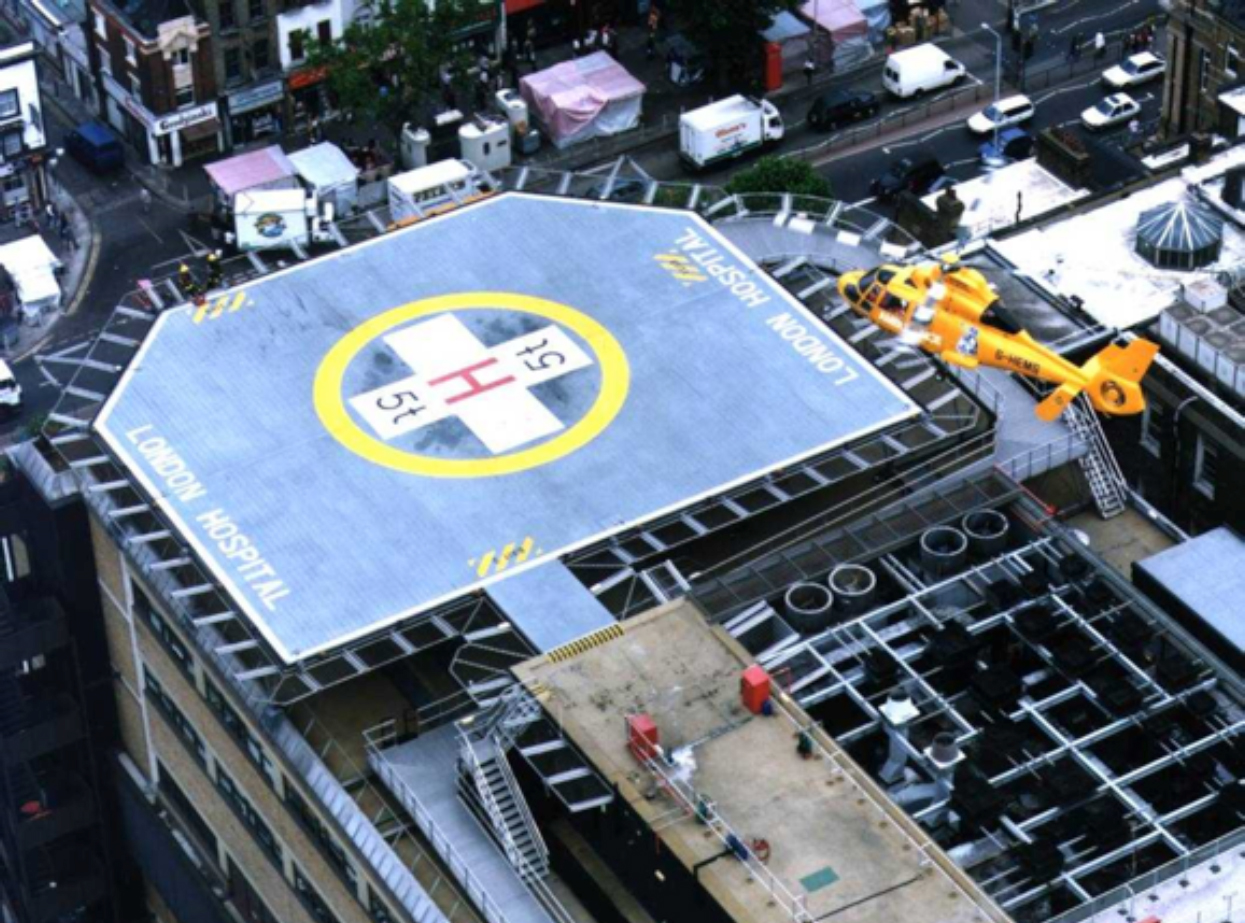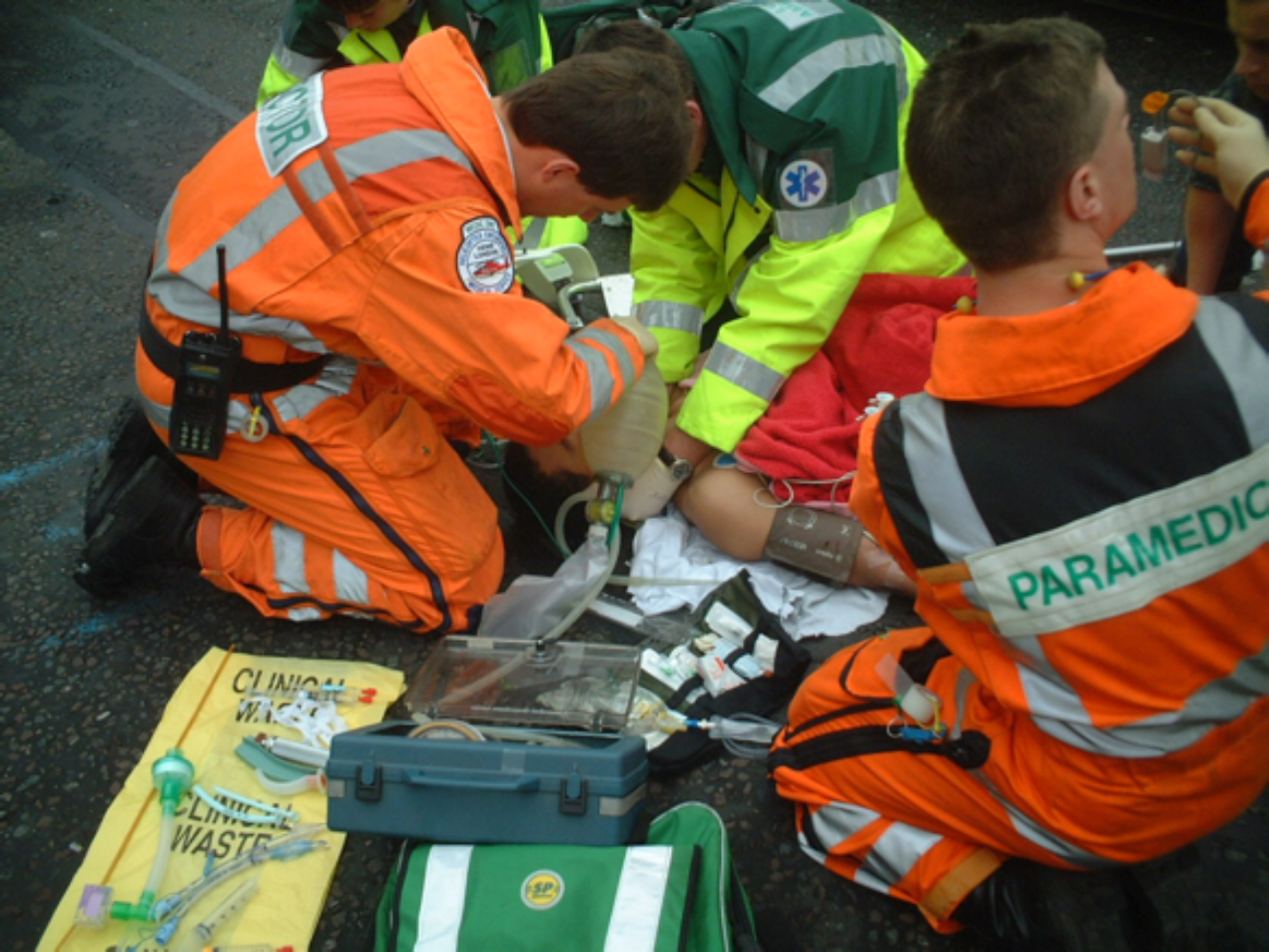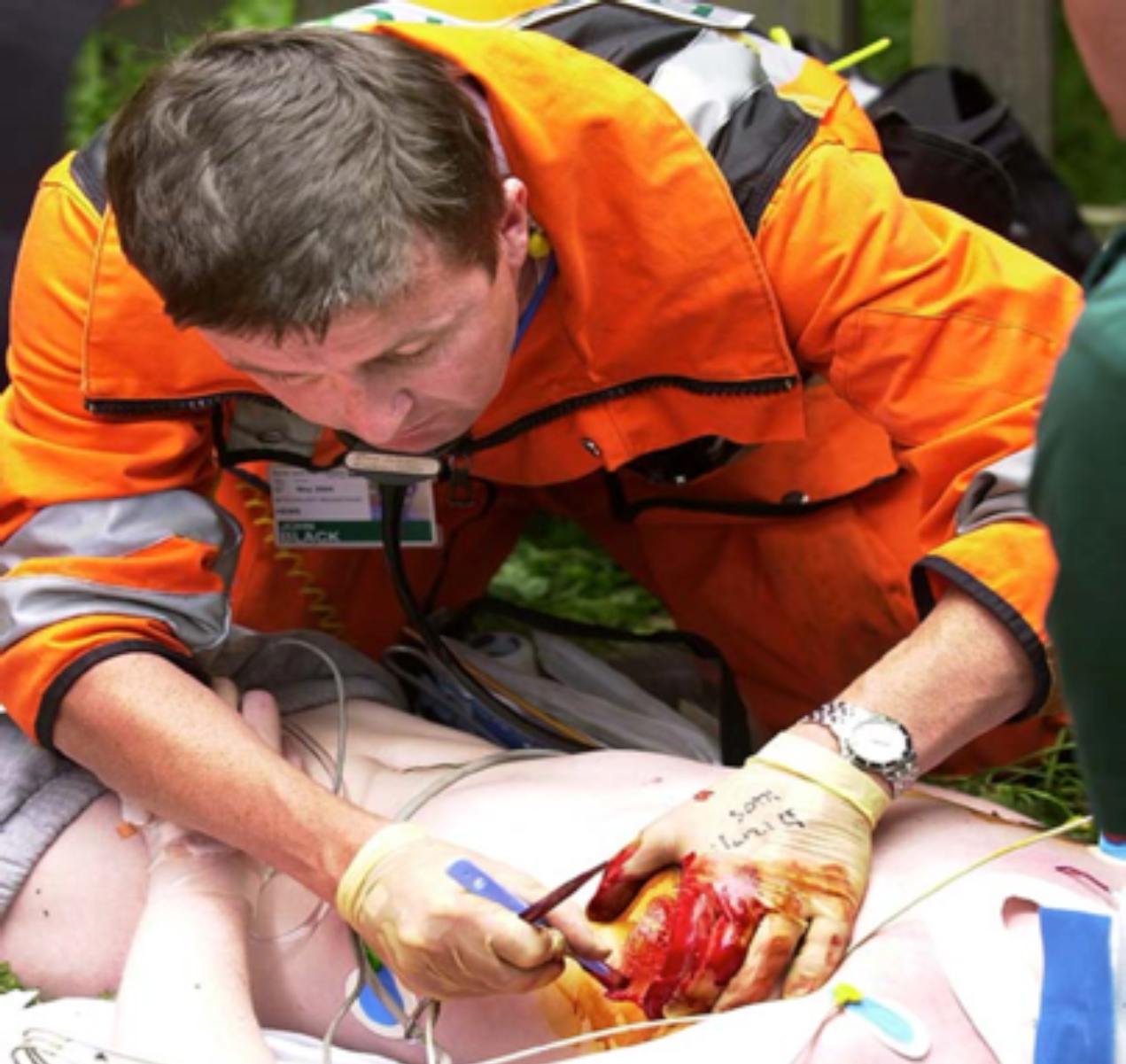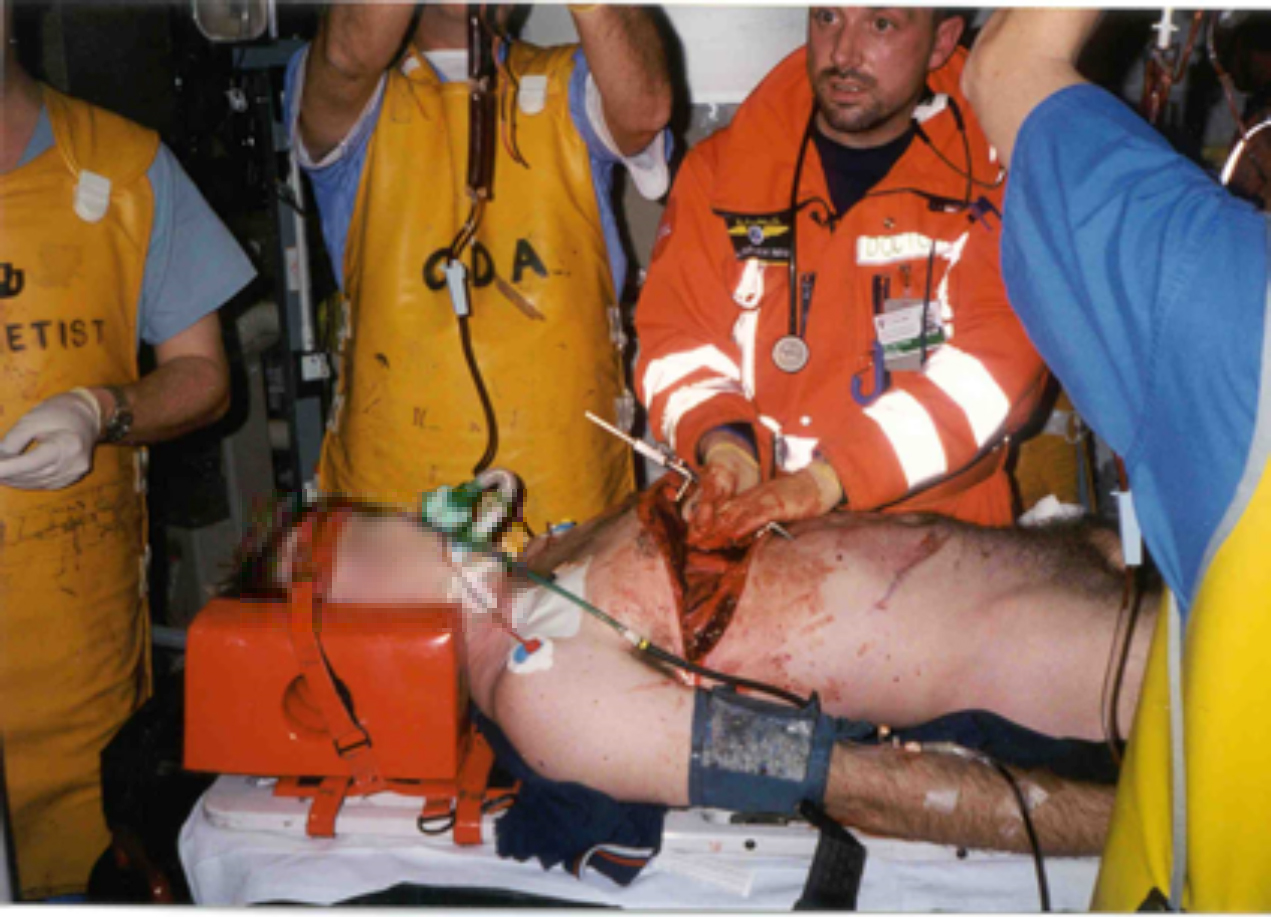The London Helicopter Emergency Medical Service (HEMS) was established in 1989 (Botha et al, 1992; Kirk et al, 1993) in response to a report published by the Royal College of Surgeons (Royal College of Surgeons, 1988), which suggested that up to a third of trauma deaths were potentially preventable with early advanced pre-hospital medical intervention. The benefits of regionalised trauma systems encompassing early pre-hospital intervention and rapid transfer to specialist Major Trauma Centres with all the necessary medical specialties on-site has been proven in other countries (Gabbe et al, 2011). The challenge then in Greater London was to provide a system able to provide enhanced clinical capabilities and expedite transfer to appropriate receiving hospitals for major trauma patients in a city with a resident population of 8 million, a daily commuter population of a further 1 million, and a road system based on 19th Century design.
It was with this in mind that Dr Alistair Wilson of the Royal London Hospital (RLH) Emergency Department (ED) first conceived the notion of a helicopter service able to rapidly deploy a specially trained doctor and paramedic to provide enhanced clinical interventions and ensure appropriate triage and transport for major trauma patients. The mission of the service was clear—to take the emergency room to the roadside. The funding mechanisms for such a system were less clear. Discussions were held between Dr Wilson and Express Newspapers, with the result that Express Newspapers became the first sponsor of London HEMS (Earlam and Wilson, 1988), providing funding for an aircraft, pilots and aviation firefighters. Paramedics were seconded from the London Ambulance Service NHS Trust (LAS) and doctors employed by the Royal London Hospital. Funding was provided for the construction of a helipad at the Royal London Hospital (Figure 1), on the basis that this was the only London hospital at the time with all the necessary clinical specialties on-site. The first mission was flown from the RLH in March 1990.

Development of the service
During the early years, London's Air Ambulance (LAA) functioned almost entirely as an aeromedical service during daylight hours. A range of drugs were used for anaesthesia and sedation, with individual clinicians employing a variety of approaches to these interventions based on previous experience. Dispatch of the aircraft was handled by specialised emergency medical dispatchers within the LAS control room, and mission cancellation rates were relatively high. The subsequent introduction of LAA paramedics led to improvements in cancellation rates and more clinically focused targeting of the team (Earlam, 1997). The goal of the service has always been to improve patient safety and deliver high-quality clinical interventions, and over time a number of Standard Operating Procedures (SOP) were developed to provide structure and governance of specific aspects of the service, such as the provision of anaesthesia, sedation and analgesia.
Roles became more clearly defined for doctors and paramedics, and checklists modelled on those used within the aviation industry were produced to further enhance safety in potentially high-risk procedures such as rapid sequence induction (RSI) anaesthesia. It quickly became clear that whilst the use of a helicopter provided a means of rapid deployment of a specialised trauma team during the day, there were also a number of major trauma patients with unmet clinical needs throughout the night. With this in mind, sponsorship for the provision of a rapid response car was obtained, and the team began to provide cover until midnight or 01:00 hours on certain nights of the week. As staffing levels increased, the frequency and duration of these shifts were increased incrementally, culminating in the introduction of a full 24 hour service in 2010.
Current operations
The LAA system remains unique within the UK in that it is the only dedicated trauma service. Other UK air ambulance services offer similar levels of pre-hospital critical care to both medical and trauma patients via doctor paramedic teams (Fullerton et al, 2009; Chesters et al, 2013), whereas others continue to fly with solely paramedic teams (Gruffudd, 2008). Although the optimal crew mix for a given operational environment is yet to be established, there is now evidence of benefit associated with specific pre-hospital critical care interventions in trauma patients (Bernard et al, 2010).
Paramedic recruitment and selection
LAA paramedics continue to be drawn from the London Ambulance Service NHS Trust and successful applicants can expect to be seconded to the Service for a period of nine months. The recruitment process commences with an internal LAS Trust advert, which usually generates in excess of 100 applications. Of these, approximately 30 will be invited to an assessment day consisting of a range of clinical and scene management scenarios alongside technical and equipment based testing. Assessors are drawn from current and past LAA doctors and paramedics in order to provide realistic scenarios and peer assessment of both technical and clinical competence as well as the ability of candidates to function under stress and integrate as part of a team. The 15 that gain the highest scores on the assessment day are invited to attend an interview with a consultant, senior paramedic and human resources representative. Candidates selected after interview commence secondments with staggered start dates throughout the following two years.
Training and education
Paramedics and doctors initially train alongside each other on the LAA Helicopter Crew Course. The course is delivered intensively over seven days, and provides a mixture of theoretical input and scenario-based work to reinforce the physician-paramedic partnership in the delivery of prehospital critical care. The course is facilitated by a dedicated faculty of experienced doctors and paramedics, supplemented by clinically current LAA paramedics and doctors and staff from the London Ambulance Service. Example course content is shown below:
Each clinician joining the service will receive on-going peer mentorship during a training month. Throughout this period the trainee doctor or paramedic will receive one-to-one support, gradually assuming a more hands-on role as their experience and competence develops. The training month culminates in a sign off day, during which the appropriate lead clinician accompanies the training and undertakes continuous assessment of clinical performance at scene as well as background knowledge in areas such as standard operating procedures, clinical equipment and pharmacology. Successful completion of this process enables the trainee to practice unsupervised and to eventually mentor new staff.
‘The goal of the service has always been to improve patient safety and deliver high-quality clinical interventions’
Once initial sign-off has been completed, paramedics are encouraged to attend weekly Death and Disability sessions facilitated by a consultant during which clinical cases are discussed and lessons learned for future practice. Paramedics are also expected to participate in monthly Clinical Governance Days, which include longitudinal audits of clinical cases attended via both the aircraft and response car. Every aspect of the call cycle is audited, beginning with firecrew and pilot activity in the case of the aircraft, before scrutinising the dispatch process and the actions of the paramedic in EOC and the clinical performance of the medical team at scene. There is frequently lively debate generated by the audit process, and this can be an unnerving experience for paramedics who have previously not been exposed to this level of clinical and operational accountability. There are opportunities for paramedics to participate in clinical audits and research projects, the findings of which may be used to refine standard operating procedures or propose novel interventions. Finally, a range of external courses in areas such as road traffic collision extrication, confined space rescue and railway incidents are often available.
Clinician led dispatch
The dispatch process is pivotal in the success of the LAA system. Identifying the clinically vulnerable patient at an early stage and dispatching an appropriate resource is essential to ensure good outcome. Appropriate dispatch avoids unnecessary cost through inappropriate aircraft and vehicle movements.
HEMS dispatches are defined in three ways:
Immediate dispatch criteria are those where little further information could be obtained, the mechanism of injury predicts there is a need for HEMS intervention, or that high injury levels are common. Requests for HEMS from other emergency services are treated as immediate dispatches. Interrogated calls are those that the paramedic in EOC identifies (through questioning the 999 caller) as requiring the extended skills of the LAA team. Crew requests are those that the paramedic has decided are not for HEMS (or that they have missed), or that an ambulance crew have decided would warrant extended intervention.
‘There are opportunities for paramedics to participate in clinical audits and research projects, the findings of which may be used to refine standard operating procedures or propose novel interventions’
Immediate dispatch criteria are shown below:
As soon as any of the above criteria become apparent, either on the call taking screen or through monitoring the call, the helicopter or car team are dispatched. Further interrogation may be appropriate if the car has a great distance to run or there is evidence of hoax or misinformation. The target for immediate dispatch is three minutes.
Other calls that are suitable for interrogation and potential dispatch are shown below:
The above list is not exclusive and anything that appears serious is interrogated. Interrogation can be in two forms. The passive or ‘silent’ interrogation is when a decision to dispatch is reached through monitoring the call in progress because the information obtained is sufficient for the medical team to be dispatched. Active interrogation is when the 999 caller is re-contacted or the call is passed to the paramedic from the call taker. In this instance, the paramedic will ask a series of questions in order to get a clear picture of whether LAA resources are required. The interrogation structure is deliberately left ‘loose’ in order that the paramedic can adapt their questions appropriately. The skill is to be able to obtain a mental picture of the scene through piecing together all the information that is available.
Clinical interventions
Rapid sequence induction (RSI) of anaesthesia is the most commonly performed enhanced clinical intervention, with an average of one RSI per 24 hour period (Harris and Lockey, 2011). The frequency with which RSI is performed varies, and it is therefore not uncommon for paramedics to participate in the procedure several times in one shift. RSI is an emergency anaesthetic requiring sedation, analgesia and neuromuscular blockade to facilitate endotracheal intubation and ventilation of spontaneously breathing patients (Davis et al, 2007). It is therefore a very different prospect to non-drug assisted intubation performed in cardiac arrest and it is imperative that paramedics operating as part of the HEMS team are competent in all aspects of their role in relation to the procedure. Guidelines on pre-hospital RSI published by the Association of Anaesthetists of Great Britain and Ireland (AAGBI) stress that the standards of care for the procedure should not differ from those applied in hospital, and that the equipment, standards of training and competence of personnel should be equivalent (Association of Anaesthetists of Great Britain and Ireland, 2009). The AAGBI state that appropriately trained paramedics may perform the role of the skilled assistant during pre-hospital RSI, and therefore HEMS paramedics have an integral role in establishing and maintaining a safe environment for pre-hospital RSI, preparation of equipment and monitoring, provision of skilled assistance during the procedure and maintenance of analgesia and sedation post procedure (Figure 2).

Familiarity with specific surgical procedures remains an important aspect of the HEMS paramedic role. The limitations associated with needle thoracocentesis have been documented, and therefore the HEMS team will perform pleural drainage in cases of pneumothorax through the use of open thoracostomies (Figure 3) in intubated and ventilated patients or, less commonly, insertion of a formal chest drain in spontaneously breathing patients (Lockey et al, 2008).

Paramedics seconded to HEMS routinely perform thoracostomies as required. In rare cases, surgical cricothyroidotomy may be required in the true cannot intubate cannot ventilate scenario. LAA has developed a two person technique to minimise the complications associated with this procedure, and therefore paramedics are expected to play an active part in cases requiring surgical cricothyroidotomy. Arguably the most controversial and radical surgical procedure performed by HEMS is the resuscitative clamshell thoracotomy (Figure 4). The procedure is performed in cases of penetrating trauma to the thorax resulting in cardiac arrest, and aims to relieve cardiac tamponade and permit internal cardiac massage. Some commentators assert that scoop-and-run approaches offer the best chance of survival (Seamon et al, 2007) or suggest alternative surgical approaches (Ashrafian and Athanasiou, 2010). However, the service has comparatively extensive experience of performing the procedure, which can yield a survival rate of 18% (Coats et al, 2001; Davies and Lockey, 2011).

In 2012, LAA became the first UK pre-hospital service to carry blood for emergency transfusion. The administration of blood is part of a package of measures to reduce blood loss, which include attention to splintage and minimising handling and the administration of tranexamic acid where indicated. Four units of O Negative blood are carried in a sealed Golden Hour™ box, which maintains a steady temperature over a 24 hour period. Blood is administered via the Buddylite™ system, which consists of a battery powered warming circuit that heats blood prior to administration. The team are also able to administer the warfarin reversal agent octaplex in cases of isolated head injury with presumed intracranial bleed (Lendrum et al, 2013). This involves undertaking near patient testing using a small monitor to measure the international normalised ratio (INR). The measurement process is similar to that employed in blood capillary glucose testing, and a raised INR should prompt the HEMS team to consider the need for warfarin reversal.
Conclusion and the future
LAA continues to provide a unique opportunity for paramedics to provide critical care to the most seriously injured patients in the capital as part of a physician-paramedic team functioning as part of a service with 25 years of experience. As the only air ambulance charity dedicated solely to pre-hospital trauma care, paramedics seconded to the service can expect to acquire significant experience in the management of a large volume of major trauma cases in an urban setting. Paramedics returning to their previous positions post secondment are then in a position to cascade this knowledge and experience to their peers. There is now also an opportunity for paramedics who have completed HEMS secondments to continue to undertake shifts as emeritus staff and contribute to on-going training and service development.

